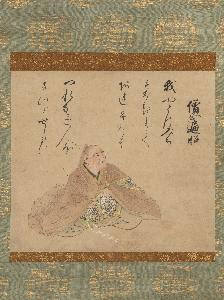Araki Katsumochi
Araki Katsumochi;Iwasa Matabei
Place: Awa Province
Born: 1578
Death: 1650
Biography:
Early Life and Influences
Araki Katsumochi, a prominent figure in Japan's early Tokugawa period, left an indelible mark on the art world with his genre scenes, historical illustrations, and captivating portraits. Born in 1578, Katsumochi was the son of Araki Murashige, a notable daimyō who met a tragic end, leading to Katsumochi's adoption of his mother's family name, Iwasa.
Artistic Style and Technique
Katsumochi's work is characterized by its distinctive figures, featuring large heads and delicately drawn features. His unique brush technique, blending Tosa and Kanō elements, allowed him to excel in both color and monochrome ink-wash painting. Despite being trained under Kanō Naizen of the renowned Kanō school, Katsumochi's style was more heavily influenced by the Tosa school.
Notable Works and Legacy
One of Katsumochi's most celebrated works is the series of portraits of the Thirty-six Poetry Immortals (1640), commissioned by Tokugawa Iemitsu for a temple. This masterpiece, signed as "the artist Matabei of the later current from Tosa Mitsunobu," showcases Katsumochi's skill in capturing historical events and classical literature.
- Rakuchu Rakugai Zu Byōbu (Funaki Version), a National Treasure, is held by the Tokyo National Museum and depicts the Kyoto landscape around 1615.
- Hōkoku Sairei Zu Byōbu, an Important Cultural Property, is housed in the Tokugawa Art Museum and showcases Katsumochi's mastery of capturing festive scenes.
- Katsumochi's workshop produced magnificent emakimono (picture scrolls) based on jōruri texts, with masterpieces like Yamanaka Tokiwa Monogatari Emaki, Jōruri Monogatari Emaki, and Horie Monogatari Emaki being designated as Important Cultural Properties.
Controversy and Legacy
There is ongoing debate among scholars regarding whether Katsumochi's works are indeed ukiyo-e or not. In Japan, he is often regarded as the originator of ukiyo-e, while some theories suggest he was an independent Tosa school painter due to his high social class patrons. Conclusion Katsumochi's enigmatic life and artistic contributions have left a lasting impact on Japanese art. His unique style, blending traditional techniques with innovative brushwork, continues to fascinate art enthusiasts worldwide.
- Explore more of Katsumochi's works at https://Wikioo.org/@/Araki-Katsumochi
- Learn about the Tosa school and its influence on Japanese art at The Kanō School Style Art Movement
- Discover more about Katsumochi's life and works at Iwasa Matabei - Wikipedia
References
- Araki Katsumochi, Wikipedia, https://en.wikipedia.org/wiki/Iwasa_Matabei
- The Kanō School Style Art Movement, Wikioo.org, https://Wikioo.org/@@/A@D3CPBV-History-Painting-Art-Movement
- Araki Katsumochi's Paintings, Wikioo.org, https://Wikioo.org/@/Araki-Katsumochi
Related Artists and Movements
- Katsushika Isai, a Japanese artist known for his landscapes and genre scenes, Wikioo.org, https://Wikioo.org/@/Katsushika-Isai
- The Tosa School, a style of Japanese art characterized by its use of gold leaf and bold colors, Wikioo.org, https://Wikioo.org/@@/A@D3CPBV-History-Painting-Art-Movement








